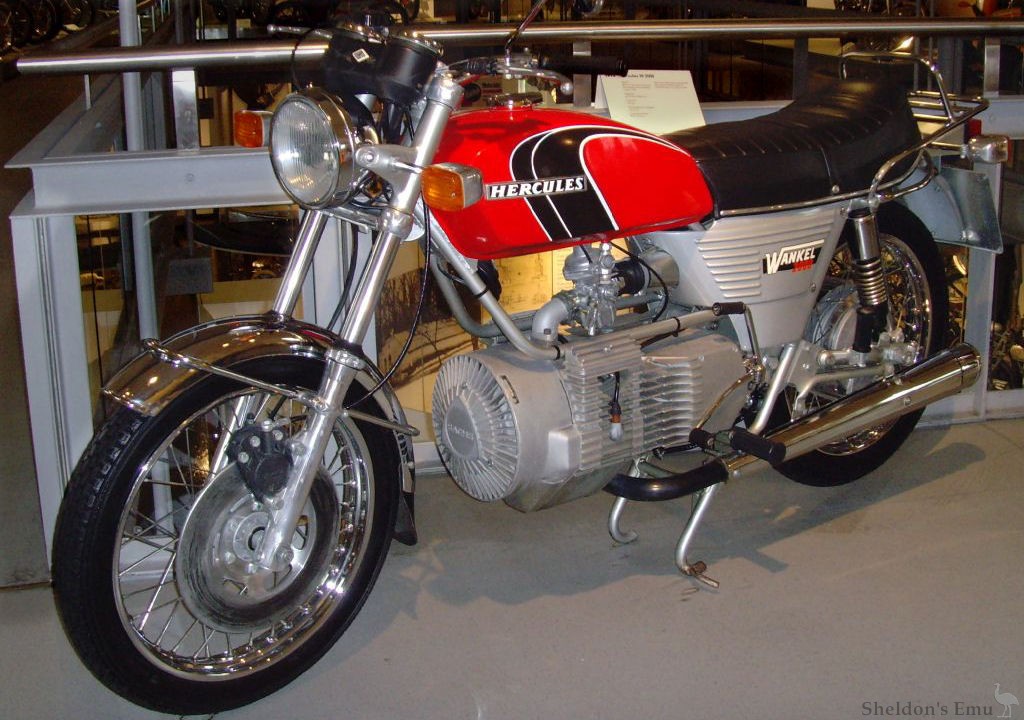



History of the Sachs Wankel Hercules
The Hercules W 2000 was sold in some markets as the DKW W 2000. This was the first production bike with a 27 h.p. (or 32 h.p., depending on source) Fitchel and Sachs rotary engine.
Cooling was achieved using a large fan at teh front of the engine and a mixture of oil and fuel (al la two-stroke) lubricated the rotors. Each combustion chamber had a volume of 294cc, allowing Hercules to claim that it was a 294ccc motorcycle. Insurance companies differed in this assesment and rated it as a triple of almost 900cc, with commensurate high fees. This, along with appalling fuel economy and not great reliability did not encourage sales.
Fri Jun 10 2016
yomas143 at hotmail.com
Great site
Hercules W2000
Hi, just wanted to congratulate you for compile so much information about european classics.
I am spanish and recently the owner of a Hercules Wankel 2000 which is being parked in a garage for 30 years. it belongs to my grandfather.
I dont know what to do with it nor what are its conditions.
I attach some pictures.
Not sure if is worth it to estore it as it can be very expensive.
Also i dont think i can sell it becuase it doesnt look in good condition, although all parts are original.
Regards
David
Madrid
NB: Images not included in post. Ed.
Post to Facebook 10th June 2016:
A fellow from Madrid emailed some pics of a very tatty W2000 (not this one) asking whether it was worth restoring. Apparently it's been in a shed unloved for 30 years. Earlier today I had coffee with a fellow who has a Suzuki Rotary and he said that if those machines are not started for some time the rotor seals are cactus, the engine requires a rebuild, and parts are like hen's teeth. Comments?
Replies:
Eddy Grabis
Any well worn engine that gets tucked away at the back of the shed for ten or more years will give trouble if trying to restart. The combination of carbon deposits and slow corrosion will eventually seize the piston rings in their grooves and you won't be able to even suck a dead fly into the combustion chamber. This why it has all ways been advised to put a measured amount of oil into each cylinder chamber if the engine is to be laid up for any length of time. Equally applies to oil engines as doe to petrol /LP gas engines. This is intended to keep the carbon deposits "moist" and reduce the possibility of ring seizure. Those of you who have ever had to fire up an old engine that has been sitting around for decades will know all about it.
A tablespoon of engine oil in each cylinder for a bit of temporary compression and a hope that it will start and run on all cylinders before the plugs foul up first. Once running, it would only be a matter of time before the rings would free up and everything was back to normal.
The rotary engine on the other hand was far more sensitive with its tip seals also liable to stick with long periods of non use.Also the tip seals wore at a far greater rate than their reciprocating engined piston ringed cousin. Many rotary owners soon learned the frustration of cranking over a hot virtually compression-less engine for ages before it would finally fire up.
Once the engine was running, it was almost OK again because now we had the centrifugal force created by the rotors actually forcing the tip seals out against the chamber contour in combination with the now re established combustion chamber pressure behind the seal. I can only guess that to restart a long dormant rotary would be to tow it in a low gear and get the rotor up to a high enough speed to eventually "dislodge those tip seals from captivity and hope a good run will restore the engine back to normal.
The Hercules indeed demonstrated how beautiful and simple a rotary motorcycle could be made. Norton did indeed put the "cat amongst the pigeons" with its race developed rotaries and track performance in a spirit similar to Mazda when it took over the original NSU unit's re development.
Unfortunately I still can't help but have misgivings about Suzuki's mighty RE7...... Either way though any one fortunate enough to capture a two wheeled rotary should do what they can to preserve what is indeed quite a short, valuable piece of motorcycling history.......
Kim Armand Nielsen
We all recognize piston rings as the standardized product they are and both pistons and -rings are mostly to find as aftermarket parts for even vintage engines. For Wankel/rotarys however are the rings ('seals' actual) made separate by the manufacturer and as this engines additional is vintage aged rarities are fitting seals almost impossible to find!
Topical sidestory: The major problem of the Wankel-engine was the piston-sealing - Until Norton got their hands on it :-o
I forgot to write that seals might be more realistic to find to the Hercules than the Suzuki, hence should be tried under all circumstances!
I might add that severe stuck/rusted seals likely might have damaged the wall of the piston chamber (note: It's not a cylinder, but a figure-8 like shaped chamber!) which neither is to repair in same matter as a traditional cylinder!
If you have a query or information about Hercules rotary-engined motorcycles please contact us